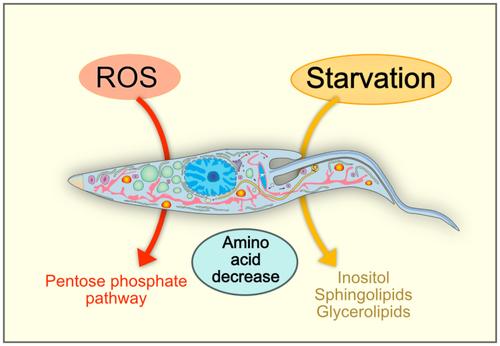当前位置:
X-MOL 学术
›
Mol. Microbiol.
›
论文详情
Our official English website, www.x-mol.net, welcomes your
feedback! (Note: you will need to create a separate account there.)
The effect of nutritional and oxidative stress on the metabolome of Trypanosoma cruzi
Molecular Microbiology ( IF 2.6 ) Pub Date : 2024-05-30 , DOI: 10.1111/mmi.15279 Michel Augusto Silva 1 , Mario Augusto Izidoro 2 , Mirella Aricó 1 , Luiz Juliano 3 , Sergio Schenkman 1
Molecular Microbiology ( IF 2.6 ) Pub Date : 2024-05-30 , DOI: 10.1111/mmi.15279 Michel Augusto Silva 1 , Mario Augusto Izidoro 2 , Mirella Aricó 1 , Luiz Juliano 3 , Sergio Schenkman 1
Affiliation

|
Trypanosoma cruzi, a flagellated protozoan, is the causative agent of Chagas disease. The parasite has developed various mechanisms to get through its intricate life cycle and adapt to different evolutionary phases. T. cruzi proliferates in the insect vector's digestive tract as an epimastigote form, encountering fluctuating nutrient availability and oxidative stress caused by the digestion of red blood cells from the mammalian host blood meal. To unravel how the parasite's metabolism adapts to these changing conditions, we conducted an analysis of the chemical species present in epimastigote forms. This involved comparing cultured parasites with those subjected to nutritional deficiency or oxidative stress using untargeted metabolomics. We looked at 21 samples: seven biological copies of parasites that were actively growing, seven samples that were put in a medium without nutrients for 3 h, and seven samples that were treated with glucose oxidase for 30 min to make H2O2 continuously. Importantly, in all conditions, parasite viability was maintained when the samples were collected. Upon nutrient removal, we observed a substantial decrease in amino acids and carbohydrate metabolites, accompanied by the accumulation of fatty acids and steroids, with the predominance of inositol and sphingolipid metabolism, along with a simultaneous decrease in the levels of H2O2. In the presence of H2O2, a significant rise in components of the pentose pathway and specific amino acids such as methionine and serine occurred, along with pathways related to an increase in antioxidant species metabolism such as ribulose 5-phosphate and glyceric acid. Conversely, fatty acid and steroid levels decrease. We found no common increase in metabolites or lipids. In contrast, eight species (succinic acid, glutamic acid, valine, 2-hydroxyisocaproic acid, alanine, indolelactic acid, proline, and lanosterol) were consumed under both stresses. These findings underscore the rapid and distinct enrichment responses in amino acids, lipids, and carbohydrates required to cope with each different environmental condition. We concluded that T. cruzi presents a flexible metabolism that rapidly adapts to variable changes in the environment.
中文翻译:

营养和氧化应激对克氏锥虫代谢组的影响
克氏锥虫是一种有鞭毛的原生动物,是美洲锥虫病的病原体。这种寄生虫已经发展出各种机制来度过其错综复杂的生命周期并适应不同的进化阶段。T. cruzi 以 epimastigote 形式在昆虫媒介的消化道中增殖,遇到由哺乳动物宿主血粉中的红细胞消化引起的营养可用性波动和氧化应激。为了揭示寄生虫的新陈代谢如何适应这些变化的条件,我们对上鞭毛体形式中存在的化学物质进行了分析。这涉及使用非靶向代谢组学将培养的寄生虫与遭受营养缺乏或氧化应激的寄生虫进行比较。我们观察了 21 个样品:7 个积极生长的寄生虫生物拷贝,7 个样品放入无营养物质的培养基中 3 小时,7 个样品用葡萄糖氧化酶处理 30 分钟以连续制造 H2O2。重要的是,在所有条件下,采集样本时都保持了寄生虫的活力。去除营养物质后,我们观察到氨基酸和碳水化合物代谢物的显着减少,伴随着脂肪酸和类固醇的积累,肌醇和鞘脂代谢占主导地位,同时 H2O2 水平降低。在 H2O2 存在下,戊糖途径的成分和特定氨基酸(如蛋氨酸和丝氨酸)的显着增加,以及与抗氧化剂物种代谢(如 5-磷酸核酮糖和甘油酸)增加相关的途径发生。相反,脂肪酸和类固醇水平降低。 我们发现代谢物或脂质没有常见的增加。相比之下,在两种压力下消耗了 8 种物种(琥珀酸、谷氨酸、缬氨酸、2-羟基异己酸、丙氨酸、吲哚酸、脯氨酸和羊毛甾醇)。这些发现强调了应对每种不同环境条件所需的氨基酸、脂质和碳水化合物的快速而独特的富集反应。我们得出结论,克氏锥虫表现出一种灵活的新陈代谢,可以迅速适应环境的变化。
更新日期:2024-05-30
中文翻译:

营养和氧化应激对克氏锥虫代谢组的影响
克氏锥虫是一种有鞭毛的原生动物,是美洲锥虫病的病原体。这种寄生虫已经发展出各种机制来度过其错综复杂的生命周期并适应不同的进化阶段。T. cruzi 以 epimastigote 形式在昆虫媒介的消化道中增殖,遇到由哺乳动物宿主血粉中的红细胞消化引起的营养可用性波动和氧化应激。为了揭示寄生虫的新陈代谢如何适应这些变化的条件,我们对上鞭毛体形式中存在的化学物质进行了分析。这涉及使用非靶向代谢组学将培养的寄生虫与遭受营养缺乏或氧化应激的寄生虫进行比较。我们观察了 21 个样品:7 个积极生长的寄生虫生物拷贝,7 个样品放入无营养物质的培养基中 3 小时,7 个样品用葡萄糖氧化酶处理 30 分钟以连续制造 H2O2。重要的是,在所有条件下,采集样本时都保持了寄生虫的活力。去除营养物质后,我们观察到氨基酸和碳水化合物代谢物的显着减少,伴随着脂肪酸和类固醇的积累,肌醇和鞘脂代谢占主导地位,同时 H2O2 水平降低。在 H2O2 存在下,戊糖途径的成分和特定氨基酸(如蛋氨酸和丝氨酸)的显着增加,以及与抗氧化剂物种代谢(如 5-磷酸核酮糖和甘油酸)增加相关的途径发生。相反,脂肪酸和类固醇水平降低。 我们发现代谢物或脂质没有常见的增加。相比之下,在两种压力下消耗了 8 种物种(琥珀酸、谷氨酸、缬氨酸、2-羟基异己酸、丙氨酸、吲哚酸、脯氨酸和羊毛甾醇)。这些发现强调了应对每种不同环境条件所需的氨基酸、脂质和碳水化合物的快速而独特的富集反应。我们得出结论,克氏锥虫表现出一种灵活的新陈代谢,可以迅速适应环境的变化。






























 京公网安备 11010802027423号
京公网安备 11010802027423号